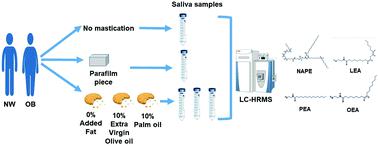当前位置:
X-MOL 学术
›
Food Funct.
›
论文详情
Our official English website, www.x-mol.net, welcomes your
feedback! (Note: you will need to create a separate account there.)
N-Acylphosphatidylethanolamines and N-acylethanolamines increase in saliva upon food mastication: the influence of the individual nutritional status and fat type in food.
Food & Function ( IF 5.1 ) Pub Date : 2020-04-30 , DOI: 10.1039/c9fo02205h Lucia De Luca 1 , Rosalia Ferracane 1 , Nancy Calderón Ramírez 1 , Paola Vitaglione 1
Food & Function ( IF 5.1 ) Pub Date : 2020-04-30 , DOI: 10.1039/c9fo02205h Lucia De Luca 1 , Rosalia Ferracane 1 , Nancy Calderón Ramírez 1 , Paola Vitaglione 1
Affiliation

|
This study aimed to evaluate the influence of the individual nutritional status on the salivary concentration of N-acylethanolamines (NAEs), including linoleoylethanolamide (LEA), oleoylethanolamide (OEA), and palmitoylethanolamide (PEA), and their precursors N-acylphosphatidylethanolamines (NAPEs) upon mastication of biscuits containing different fats. Three types of biscuits were formulated with 10% extra-virgin olive oil (EVOB), 10% palm oil (PALMB) or 10% paraffin oil (0% lipids, CONB). Twenty-five healthy subjects, 12 normal weight (NW, 9 F, 30.4 ± 8.7 years) and 13 obese (OB, 8 F, 35.5 ± 10.7 years) participated in a randomized crossover study. Fasting subjects collected unstimulated saliva (US) and stimulated saliva by masticating a parafilm piece (PP), and CONB, EVOB and PALMB. NAPEs, LEA, OEA and PEA were quantified in saliva samples by liquid chromatography-high-resolution mass spectrometry. The results showed that salivary NAPE and NAE concentrations in OB were higher than in NW in both US (NAPEs: 280.0 ± 45.4 ng mL-1vs. 121.8 ± 24.4 ng mL-1, p = 0.015; NAEs: 10.8 ± 1.4 ng mL-1vs. 4.8 ± 0.8 ng mL-1, p = 0.002, respectively) and PP (NAPEs: 259.8 ± 47.1 ng mL-1vs. 121.7 ± 16.9 ng mL-1, p = 0.049; NAEs: 6.1 ± 0.8 ng mL-1vs. 3.8 ± 0.4 ng mL-1, p = 0.03, respectively). NAPE and LEA levels were similar in US and PP, while the levels of OEA and PEA were lower in PP vs. US. Compared to PP, biscuit mastication increased the salivary NAPEs, LEA, OEA and overall NAEs in NW and OB. NAPEs increased in the order of EVOB = CONB > PALMB in NW and EVOB > CONB = PALMB in OB. LEA, OEA and overall NAEs increased similarly with all the biscuits in NW and in the order of EVOB > PALMB > CONB in OB. In contrast, the PEA concentration did not vary in saliva upon biscuit mastication in NW and neither with EVOB in OB, while it lowered with CONB and PALMB in OB. In conclusion, OB showed higher salivary levels of NAPEs and NAEs than NW. Mastication itself did not vary salivary NAPEs and LEA but reduced OEA, PEA and overall NAEs. Biscuit mastication increased salivary NAPEs and all NAEs, but PEA. Altogether, the data suggested that NAPEs and NAEs were released in saliva from biscuits at levels influenced by the individual nutritional status and biscuit type. These findings may have implications in molecular mechanisms underpinning gustatory processes in humans.
中文翻译:

食物咀嚼后唾液中的N-酰基磷脂酰乙醇胺和N-酰基乙醇胺增加:食物中个体营养状况和脂肪类型的影响。
这项研究旨在评估个体营养状况对唾液中N-酰基乙醇胺(LEA),油酰基乙醇酰胺(OEA)和棕榈酰乙醇酰胺(PEA)及其前体N-酰基磷脂酰乙醇胺(NAPEs)唾液中N-酰基乙醇胺浓度的影响。咀嚼含有不同脂肪的饼干后。三种类型的饼干分别由10%的初榨橄榄油(EVOB),10%的棕榈油(PALMB)或10%的石蜡油(0%脂质,CONB)配制而成。25名健康受试者,12正常体重(净重,9 F,30.4±8.7岁)和13肥胖(OB,8 F,35.5±10.7岁)参加了一项随机交叉研究。禁食的受试者收集未刺激的唾液(美国),并通过咀嚼肺旁膜片(PP),CONB,EVOB和PALMB刺激唾液。NAPE,LEA,通过液相色谱-高分辨率质谱法定量分析唾液样品中的OEA和PEA。结果表明,在美国两个地区,OB唾液中NAPE和NAE的浓度均高于西北地区(NAPE:280.0±45.4 ng mL-1,121.8±24.4 ng mL-1,p = 0.015; NAE:10.8±1.4 ng- 1vs。4.8±0.8 ng mL-1,p = 0.002)和PP(NAPEs:259.8±47.1 ng mL-1vs。121.7±16.9 ng mL-1,p = 0.049; NAEs:6.1±0.8 ng mL-1vs 3.8±0.4 ng mL-1,p = 0.03)。与美国相比,美国和PP中的NAPE和LEA水平相似,而PP中OEA和PEA的水平较低。与PP相比,饼干咀嚼增加了西北和OB的唾液NAPE,LEA,OEA和总体NAE。在NW中,NAPE的顺序为EVOB = CONB> PALMB,而在OB中,EVOB> CONB = PALMB。LEA,在西北地区,所有饼干的OEA和总体NAE均以类似的方式增加,在OB中依次为EVOB> PALMB> CONB。相比之下,西北地区的饼干咀嚼时唾液中的PEA浓度没有变化,而OB中的EVOB则没有,而OB中的CONB和PALMB则降低了。总之,OB显示出NAP和NAE的唾液水平高于NW。咀嚼本身并不会改变唾液NAPE和LEA,但会减少OEA,PEA和总体NAE。饼干咀嚼增加了唾液中的NAPE和所有NAE,但增加了PEA。总体而言,数据表明,饼干中唾液中释放的NAPE和NAE受个体营养状况和饼干类型的影响。这些发现可能对支撑人类味觉过程的分子机制有影响。相比之下,西北地区的饼干咀嚼时唾液中的PEA浓度没有变化,而OB中的EVOB则没有,而OB中的CONB和PALMB则降低了。总之,OB显示唾液中NAPE和NAE的含量高于NW。咀嚼本身并不会改变唾液NAPE和LEA,但会减少OEA,PEA和总体NAE。饼干咀嚼增加了唾液中的NAPE和所有NAE,但增加了PEA。总体而言,数据表明,饼干中唾液中释放的NAPE和NAE受个体营养状况和饼干类型的影响。这些发现可能对支撑人类味觉过程的分子机制有影响。相比之下,西北地区的饼干咀嚼时唾液中的PEA浓度没有变化,而OB中的EVOB则没有,而OB中的CONB和PALMB则降低了。总之,OB显示出NAP和NAE的唾液水平高于NW。咀嚼本身并不会改变唾液NAPE和LEA,但会减少OEA,PEA和总体NAE。饼干咀嚼增加了唾液中的NAPE和所有NAE,但增加了PEA。总体而言,数据表明,饼干中唾液中释放的NAPE和NAE受个体营养状况和饼干类型的影响。这些发现可能对支撑人类味觉过程的分子机制有影响。OB显示NAPE和NAE的唾液水平高于西北地区。咀嚼本身并不会改变唾液NAPE和LEA,但会减少OEA,PEA和整体NAE。饼干咀嚼增加了唾液中的NAPE和所有NAE,但增加了PEA。总体而言,数据表明,饼干中唾液中释放的NAPE和NAE受个体营养状况和饼干类型的影响。这些发现可能对支撑人类味觉过程的分子机制有影响。OB显示NAPE和NAE的唾液水平高于西北地区。咀嚼本身并不会改变唾液NAPE和LEA,但会减少OEA,PEA和整体NAE。饼干咀嚼增加了唾液中的NAPE和所有NAE,但增加了PEA。总体而言,数据表明,饼干中唾液中释放的NAPE和NAE受个体营养状况和饼干类型的影响。这些发现可能对支撑人类味觉过程的分子机制有影响。
更新日期:2020-04-24
中文翻译:

食物咀嚼后唾液中的N-酰基磷脂酰乙醇胺和N-酰基乙醇胺增加:食物中个体营养状况和脂肪类型的影响。
这项研究旨在评估个体营养状况对唾液中N-酰基乙醇胺(LEA),油酰基乙醇酰胺(OEA)和棕榈酰乙醇酰胺(PEA)及其前体N-酰基磷脂酰乙醇胺(NAPEs)唾液中N-酰基乙醇胺浓度的影响。咀嚼含有不同脂肪的饼干后。三种类型的饼干分别由10%的初榨橄榄油(EVOB),10%的棕榈油(PALMB)或10%的石蜡油(0%脂质,CONB)配制而成。25名健康受试者,12正常体重(净重,9 F,30.4±8.7岁)和13肥胖(OB,8 F,35.5±10.7岁)参加了一项随机交叉研究。禁食的受试者收集未刺激的唾液(美国),并通过咀嚼肺旁膜片(PP),CONB,EVOB和PALMB刺激唾液。NAPE,LEA,通过液相色谱-高分辨率质谱法定量分析唾液样品中的OEA和PEA。结果表明,在美国两个地区,OB唾液中NAPE和NAE的浓度均高于西北地区(NAPE:280.0±45.4 ng mL-1,121.8±24.4 ng mL-1,p = 0.015; NAE:10.8±1.4 ng- 1vs。4.8±0.8 ng mL-1,p = 0.002)和PP(NAPEs:259.8±47.1 ng mL-1vs。121.7±16.9 ng mL-1,p = 0.049; NAEs:6.1±0.8 ng mL-1vs 3.8±0.4 ng mL-1,p = 0.03)。与美国相比,美国和PP中的NAPE和LEA水平相似,而PP中OEA和PEA的水平较低。与PP相比,饼干咀嚼增加了西北和OB的唾液NAPE,LEA,OEA和总体NAE。在NW中,NAPE的顺序为EVOB = CONB> PALMB,而在OB中,EVOB> CONB = PALMB。LEA,在西北地区,所有饼干的OEA和总体NAE均以类似的方式增加,在OB中依次为EVOB> PALMB> CONB。相比之下,西北地区的饼干咀嚼时唾液中的PEA浓度没有变化,而OB中的EVOB则没有,而OB中的CONB和PALMB则降低了。总之,OB显示出NAP和NAE的唾液水平高于NW。咀嚼本身并不会改变唾液NAPE和LEA,但会减少OEA,PEA和总体NAE。饼干咀嚼增加了唾液中的NAPE和所有NAE,但增加了PEA。总体而言,数据表明,饼干中唾液中释放的NAPE和NAE受个体营养状况和饼干类型的影响。这些发现可能对支撑人类味觉过程的分子机制有影响。相比之下,西北地区的饼干咀嚼时唾液中的PEA浓度没有变化,而OB中的EVOB则没有,而OB中的CONB和PALMB则降低了。总之,OB显示唾液中NAPE和NAE的含量高于NW。咀嚼本身并不会改变唾液NAPE和LEA,但会减少OEA,PEA和总体NAE。饼干咀嚼增加了唾液中的NAPE和所有NAE,但增加了PEA。总体而言,数据表明,饼干中唾液中释放的NAPE和NAE受个体营养状况和饼干类型的影响。这些发现可能对支撑人类味觉过程的分子机制有影响。相比之下,西北地区的饼干咀嚼时唾液中的PEA浓度没有变化,而OB中的EVOB则没有,而OB中的CONB和PALMB则降低了。总之,OB显示出NAP和NAE的唾液水平高于NW。咀嚼本身并不会改变唾液NAPE和LEA,但会减少OEA,PEA和总体NAE。饼干咀嚼增加了唾液中的NAPE和所有NAE,但增加了PEA。总体而言,数据表明,饼干中唾液中释放的NAPE和NAE受个体营养状况和饼干类型的影响。这些发现可能对支撑人类味觉过程的分子机制有影响。OB显示NAPE和NAE的唾液水平高于西北地区。咀嚼本身并不会改变唾液NAPE和LEA,但会减少OEA,PEA和整体NAE。饼干咀嚼增加了唾液中的NAPE和所有NAE,但增加了PEA。总体而言,数据表明,饼干中唾液中释放的NAPE和NAE受个体营养状况和饼干类型的影响。这些发现可能对支撑人类味觉过程的分子机制有影响。OB显示NAPE和NAE的唾液水平高于西北地区。咀嚼本身并不会改变唾液NAPE和LEA,但会减少OEA,PEA和整体NAE。饼干咀嚼增加了唾液中的NAPE和所有NAE,但增加了PEA。总体而言,数据表明,饼干中唾液中释放的NAPE和NAE受个体营养状况和饼干类型的影响。这些发现可能对支撑人类味觉过程的分子机制有影响。











































 京公网安备 11010802027423号
京公网安备 11010802027423号